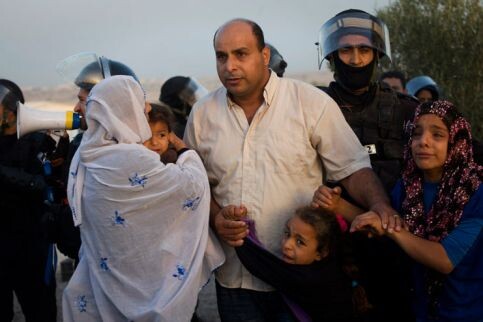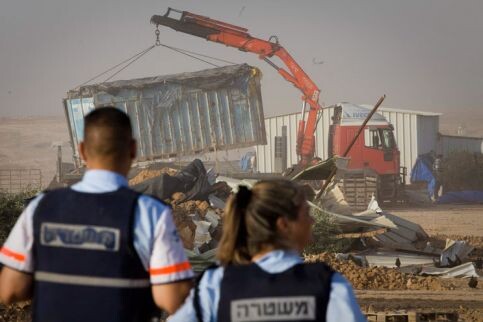The Electronic Intifada 28 July 2010

A family looks on as Israeli forces raze al-Araqib village, 27 July 2010. (ActiveStills)
Early morning on 27 July, Israeli bulldozers, flanked by helicopters and throngs of police, demolished the entire Bedouin village of al-Araqib in the northern Negev desert. Despite their land rights cases still pending in the court system, hundreds of al-Araqib villagers were instantly made homeless a month after Israeli police posted demolition orders.
Eyewitness reports say the police were accompanied by several busloads of right-wing Israeli civilians who cheered during the demolitions.
The Electronic Intifada spoke with Dr. Yeela Ranaan of the Regional Council for Unrecognized Villages (RCUV) in the Negev, who was in al-Araqib all day long during the demolitions.
“Approximately 1,500 Israeli police came at 5:30 in the morning and evacuated everyone from their beds,” Ranaan said. “They brought tear gas and water cannons, but didn’t use them. There was a handful of Israeli peace activists who had come the night before to stay with the villagers, and the police beat them up and detained them. Once they evacuated everyone in the village, they started to demolish it. It took three hours to flatten the village. For the people of al-Araqib, it was a nightmare to see their village destroyed.”
Since the establishment of the State of Israel in 1948, al-Araqib villagers have been fighting for recognition in the courts. Ranaan told The Electronic Intifada that in the early 1950s, after they were forcefully expelled from their land by Israeli forces, villagers were fined for “trespassing” in their own homes by the Israeli government. Israel has refused to acknowledge al-Araqib villagers’ land deeds and receipts of land taxes paid to the Ottoman authorities well before Israel’s establishment.
“As we speak, the fate of al-Araqib hasn’t been decided in a court,” Ranaan said. “Despite this, Israel came and demolished the homes. Israel is not just changing the facts on the ground, it’s erasing them.”
“Israel is treating us like cockroaches”
More than 110,000 Palestinian Bedouin live in dozens of so-called “unrecognized villages” throughout the State of Israel, and nearly 80 percent live in the Negev. Since 1948, Israel has refused to acknowledge the villages, and therefore deny basic services such as water, electricity, roads, schools and waste management.
During the demolitions yesterday, Sulaiman abu Mdian, a 29-year-old father of four who works as a chicken farmer, told CNN that “the State of Israel is treating us like cockroaches.”
In an emailed press release following the destruction of al-Araqib, RCUV admonished the Israeli government’s policies of accelerating home demolitions against Palestinian Bedouin communities across the state.
“The destruction’s declared aim is to facilitate plans by the Jewish National Fund to plant a [forest] on the site,” the release stated. “We regard this demolition as a criminal act. Bedouin citizens of Israel are not enemies, and forestation of the Negev is not a reasonable pretext for destroying a community which is more than 60 years old, dispossessing its residents and violating the basic rights of hundreds of Israeli civilians, men, women and children.”
“This act by the state authorities is no ‘law enforcement’ — it is an act of war, such as is undertaken against an enemy,” RCUV added. “This act cannot be dissociated from yesterday’s statement by Prime Minister [Benjamin] Netanyahu, who at the cabinet meeting sounded a warning about ‘a situation in which a demand for national rights will be made from some quarters inside Israel, for example in the Negev, should the area be left without a Jewish majority. Such things happened in the Balkans, and it is a real threat.’ Presenting the Bedouin citizens of Israel as ‘a real threat’ gives legitimacy to the expulsion of Israel’s Bedouin citizens from the Negev in order to ‘Judaize’ it. We call on all who care for democracy to give their support to this threatened community.”

Al-Araqib has been fighting for recognition ever since the State of Israel was declared in 1948. (ActiveStills)
The Electronic Intifada asked Ranaan if the situation in al-Araqib will look similar to what’s happening in the nearby Bedouin village of Twail abu Jarwal, which has been demolished more than forty times in the last few years.
“These are the two villages that the Israeli government wants to beat, to make an example of,” Ranaan remarked. “The government is experimenting with these villages. People in al-Araqib and Twail abu Jarwal have more determination and more resources than other villages. Israel wants to find out how much force is needed to evacuate and erase a village. They want to replicate the methods. And they want villagers elsewhere to see what’s happening here as a threat.”
Ranaan told The Electronic Intifada that solidarity actions are being planned as villagers of al-Araqib set up temporary housing on their land.
“They already put up a few tents, and they’ll be staying at different locations until every family will put up a makeshift home on their land,” she said. “But they know that their homes will be demolished again and again. People should put pressure on the Israeli government. International pressure is important. Activists can come and visit, and they can join villagers on their land for Friday prayers. The more people in solidarity, the stronger they are. Once their resistance breaks, then we’ve lost everything.”
More al-Walaja land confiscated
Meanwhile, in the occupied West Bank, Israel announced construction of at least 100 settlement colony units in the Bethlehem district as Israeli bulldozers and construction vehicles confiscated more Palestinian land in al-Walaja. At the same time, Israeli occupation forces demolished homes in Area C, continuing a pattern of increased demolitions and rights violations there in the last few months.
The 1995 Israeli-Palestinian Interim Agreement on the West Bank and Gaza Strip (also known as Oslo II) categorized land in the West Bank into areas A, B and C. According to the agreement, Area A is under the control of the Palestinian Authority (PA) and Area B under the joint control of Israel and the PA. Approximately 95 percent of the Palestinian population live in these two areas, though they make up only 40 percent of the land area. Israel has full military control over Area C.
Secretary General of al-Mubadara Palestinian National Initiative Dr. Mustafa Barghouti told the Bethlehem-based Maan News Agency that Israeli forces began bulldozing land and constructing barbed wire fence on al-Walaja land in “an attempt to thwart Palestinian land owners from protesting the confiscation” (“Barghouthi: 100 settlements underway in Beit Jala,” 18 July).
Barghouti reported that the work began in secret to “avoid the exposure of the Netanyahu government’s false claims of freezing settlement construction.”
Israel is also finishing construction of its wall in the Bethlehem suburb of Beit Jala, next to al-Walaja. When finished, the wall will completely encircle the Bethlehem area and will cut off thousands of Palestinians from their land. Israel began building the wall in the Bethlehem district in 2004.
Palestinian residents of al-Walaja and Beit Jala, accompanied by international human rights activists, have been trying to resist the ongoing encroachment of the wall and settlements in the area. Protesters have been fired upon by Israeli forces using stun grenades and tear gas.
Property destruction in Jordan Valley
And last week, Israeli forces destroyed Hmayyir and Ein Ghazal in the Farasiya region of the Jordan Valley, demolishing approximately 55 homes, livestock pens, tents, clay ovens, bathrooms and storage structures. More than a hundred Palestinians were displaced, including 52 children. The villages had been declared “live fire zones” by Israeli officials last month, and eviction orders were posted on the homes of families in the village, according to Amnesty International.
Amnesty stated in a press release that along with the Farasiya villages, families living in the smaller villages of Ein al-Hilwe and Ein al-Beida — also in Area C — were served with eviction and demolition orders.
Philip Luther, Amnesty’s Deputy Director for the Middle East and North Africa, stated in the press release that “these recent demolitions intensify concerns that this is part of a government strategy to remove the Palestinian population from the parts of the West Bank known as Area C, over which Israel has complete control in terms of planning and construction” (“Israel intensifies West Bank home demolitions,” 21 July 2010).
Amira Hass reported for the Israeli daily Haaretz that during the past year, the Israeli military had set up “hundreds of warning signs” near Palestinian villages and farming areas, marking them as “closed military areas … Such a sign was set up at the entrance to Farasiya” (“IDF destroys West Bank village after declaring it military zone,” 21 July 2010).
Haaretz spoke to a coordinator with the popular committee in the Jordan Valley who reported that Israel has consistently cut off Palestinian farmers and villagers from their water sources, destroyed drinking and irrigation pipes from streams and prohibited them from using water wells that the Israeli water company Mekorot had established in the region.
“Since 1967, Israel has prevented Palestinian communities in the Jordan Valley from growing, whether by cutting off their water supply, declaring large areas as live fire zones or banning all construction,” Hass reported.


